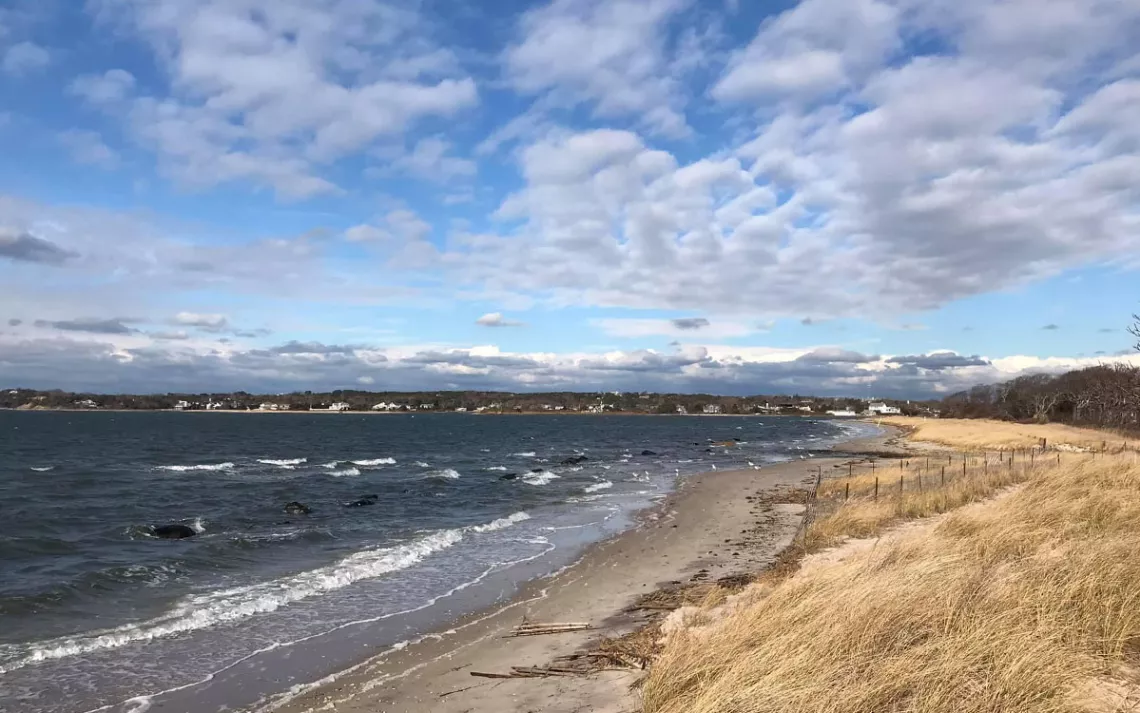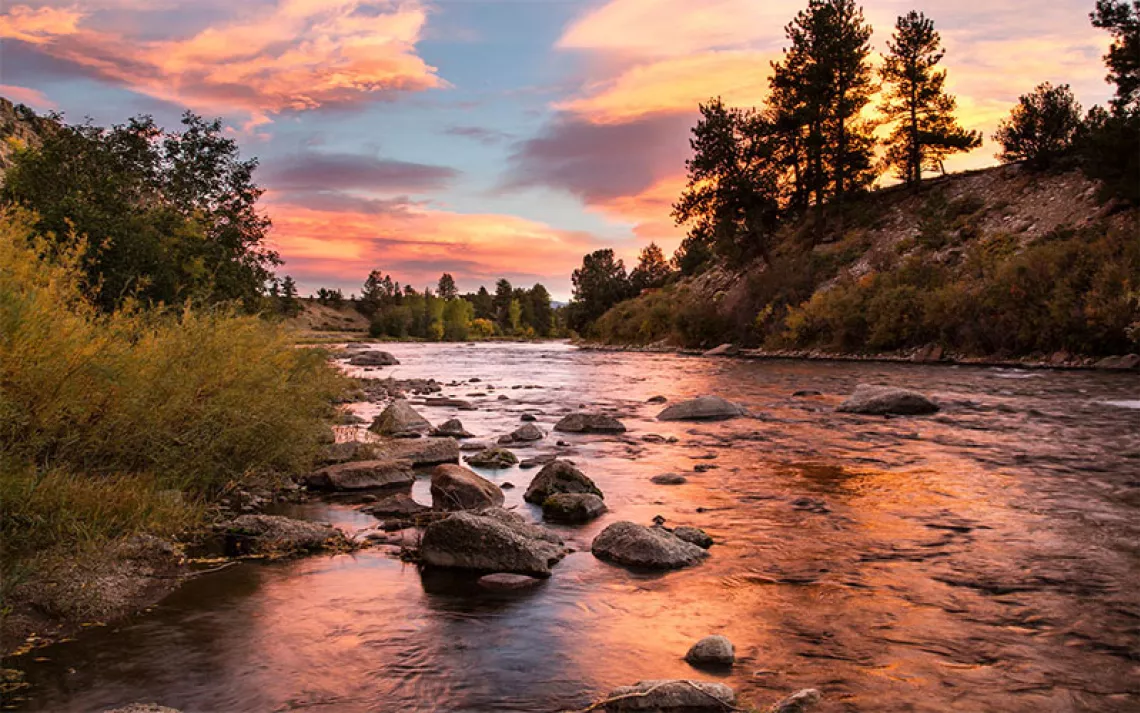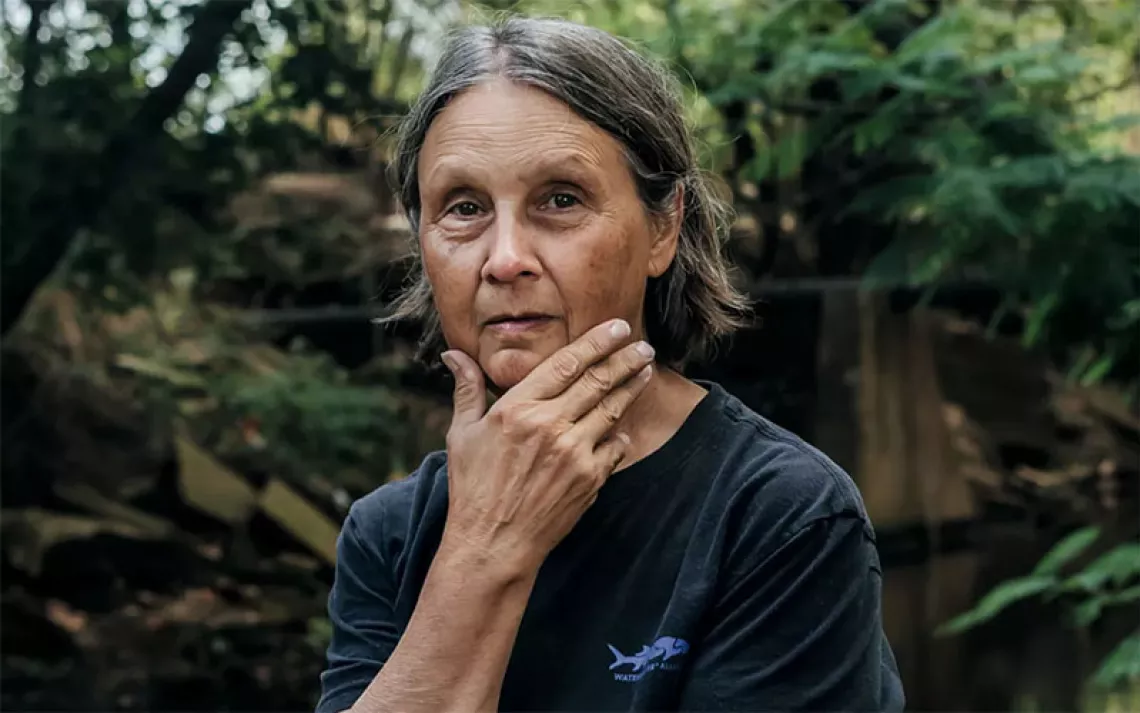This Long Island Tribe Is Dealing With the Impact of Climate Change
The Shinnecock are using nature-based solutions to save their ancestral lands from coastal erosion

Three elements of the project: beach nourishment, dune grass restoration, and boulders for a wave break to help mitigate erosion. | Photo by Shavonne Smith
Becky Genia has spent most of her 67 years on the Shinnecock Reservation, 800 acres on the far eastern side of Long Island’s Shinnecock Bay. Sandwiched between multimillion-dollar mansions and yacht clubs that serve as a playground for uber-rich New Yorkers, it may be hard to imagine a bigger threat to the tiny spit of land than encroaching development. But climate change looms even larger.
A little more than a decade ago, scientists projected that the Shinnecock Reservation would be underwater by 2050. This timeline has since moved up to reflect an accelerated change of pace. Climate models now predict that the peninsula where the reservation is situated will be underwater by 2040, with chronic floods of six feet or more by the end of the century. As sea levels have continued to rise over the years, Genia has watched storms increase in frequency and intensity, but Superstorm Sandy in 2012 is what sticks out the most. The storm devastated the peninsula, leaving its 3000-foot coastline barren and uneven. The beach turned into stagnant pools of water overrun by mosquitoes and other vectors of disease.
“Because of the winds and sea level rise, we were so flooded there were little creeks and streams everywhere,” Genia recalled. “The water came through the woods, and you could have taken a canoe from my door.”
Ultimately, Sandy turned out to be a boon for the tribe. With assistance from the US Geological Survey (USGS) and marine biologists from Cornell Cooperative Extension of Suffolk County, the tribe put together a proposal for a Hurricane Sandy relief grant. They ended up receiving a $3.8 million grant from the National Fish and Wildlife Foundation’s Hurricane Sandy Coastal Resiliency Competitive Grant Program to rebuild the vanishing beach. Rather than erect seawalls or bulkheads that can lead to greater habitat loss and coastal erosion, the Shinnecock were determined to build a protective living shoreline that worked with nature instead of against it. It was the perfect opportunity to show how adapting to climate change can work in tandem with creating wildlife habitat while bolstering the community’s resilience to the effects of a warming world.
“A lot of it has to do with our preference for maintaining our natural environment as much as possible,” Shavonne Smith, the director of the Shinnecock Environmental Department, said. “We recognized how important it was to get more space between the edge of the reservation and the water. . . . Our collective mindset was just wanting to return the beach to what it naturally looked like. We were fortunate to find partners that were onboard with that vision and to help us really continue that forward.”
The tribal partners worked with nonprofits and federal, state, and local agencies to develop a comprehensive plan for reviving the shoreline and preventing further erosion. Called the Coastal Habitat Restoration Project, the plan includes a combination of scientific and traditional knowledge that reinforces the Shinnecock’s commitment to the natural environment. Tribal members grew eel, dune, duck, and cord grasses in a greenhouse and planted them along the edges of the beach surrounded by a protective fence to prevent further erosion. They placed heavy boulders along the shoreline surrounded by smaller rocks to add an extra layer of protection. Staff with the Suffolk County public works department dredged 30,000 cubic yards of sand from the bottom of a nearby canal that was used to create a 150-foot buffer to the shoreline.
Having lost all their oyster reefs, which help lessen the power of storm surges, the community opened a solar-powered hatchery and began growing oyster larvae in tanks. Once matured, the oysters were planted on the seafloor to create reefs to serve as barriers to storms and tides.
“At the time, there were a lot of people talking about this, but no one was actually doing it, and they sought out ways to make a nature-based solution,” said Joyce Novak, the executive director of the Peconic Estuary Partnership, who worked with the tribe to develop a resiliency plan. “They wanted to come up with solutions that are not just dumping sand back on a beach to watch it disappear a year or two later.”
Aside from the lingering effects of Superstorm Sandy, the tribal reservation is facing a climate change trifecta—sea level rise, increased storm frequency and intensity, and a very high groundwater table, which leads to more flooding during high tide. The Shinnecock are clear-eyed about the threat their peninsula faces and know they must remain vigilant. “Climate change is on everybody’s mind,” Smith said. “The biggest threat is the erosion, flooding, and migrating wetlands that are moving further north on the peninsula.”
In addition to restoring ecosystems, the tribe is also looking to revive long-held traditional practices that help mitigate the threats of rising waters. In 2020, Genia was one of the six female tribal members who put their long ancestral traditional relationship with the sea and seaweed toward a more long-term response to climate change. “A couple of seaweed farmers had reached out to us about farming kelp,” Genia said. “Because we're land protectors, water protectors, grave protectors, it was a natural thing for us to say yes to.”
The women launched the Shinnecock Kelp Farmers, the first Indigenous-owned and operated kelp farm on the East Coast, to bolster its climate-resiliency plans. The long, stalky seaweed has many ecologically restorative water-quality, habitat, and climate benefits. It acts as a carbon sink and absorbs nitrogen pollution from aging septic systems and fertilizer runoff that has negatively impacted water quality and biodiversity.
“Shinnecock Bay, like many of the waters in Long Island, has water quality issues, and kelp absorbs nitrogen, which improves water quality,” Kevin Munroe, Long Island preserve director at the Nature Conservancy, said. “A whole community of aquatic wildlife depend on kelp, so their kelp harvesting also helped support biodiversity in the bay.”
Eventually, the farmers plan to harvest the kelp sustainably at scale to provide an eco-friendly alternative to conventional fertilizer. “It’s not just a whim. This is something for future generations,” Genia said.
The years of restorative and scientific work have clearly paid off. In 2022, Mission Blue, an international organization that supports the protection of waters around the world, named Shinnecock Bay a new “Hope Spot,” an iconic ocean region identified as among the most pristine on the globe.
The new living shoreline has collectively improved tidal flushing, restored the wetland systems, and improved the wildlife habitats. Increasing numbers of monarch butterflies, dragonflies, marshland birds, and even wild turkeys have been seen visiting the area. “We’re fortunate to have the abundance of wildlife that we’re sharing the space with,” Smith said.
At the same time, the rising sea level and a number of climate-related storms that continue to wreak havoc on the coastline remind them that they must remain vigilant protectors of the peninsula and its ecosystems.
Melba Newsome is a 2023 Alicia Patterson fellow. This article is part of her year-long reporting series on climate displacement and people of color.
 The Magazine of The Sierra Club
The Magazine of The Sierra Club



